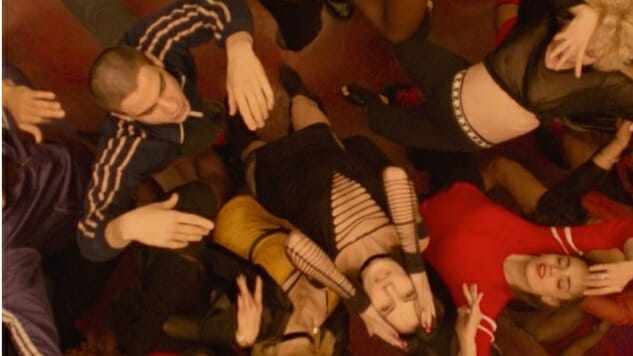
1. Gaspar Noe has been so openly confrontational and provocative for so long that it’s easy to forget just how powerful a filmmaker he can be. He is deliberately repulsive, sometimes to the detriment of his own films; I don’t care how structurally inventive Irreversible is, I am never, ever sitting through that goddamned movie again. But there is an undeniable hypnotic fervor to his movies, from the sordid (but also sort of lovely) kink of Love to the elliptical madness of Enter the Void. His movies are as high concept as the most hackneyed Hollywood blockbuster, but his relentlessness in following those concepts to their logical conclusion is impossible not to respect, even when you want to run screaming out of the theater. I’m not sure I’d like to spend much time inside Noe’s brain, but I have the darndest time getting his movies out of mine.
2. The immediate thrill of Climax, Noe’s newest and unquestionably best film, is how, for the first time, you see him letting go a little bit, releasing some of his notorious control, letting his films and (most important) his characters breathe a little bit—to be themselves. The film opens with home-camera footage—the film takes place in 1996, for reasons that I’d probably understand a lot better if I were French—of a series of dancers, readying for a troupe tour of the United States, answering questions about their hopes and dreams, their desires, their fears, their basic motivations. It’s a slick, kind of cheap, but still incredibly effective way for Noe to give us just enough information about these dancers that we feel for them when they go through whatever Noe is about to put them through. (And you know he’s going to put them through something.) But it’s what comes next that’s most exciting: during rehearsal, a glorious dance routine featuring the entire crew, both meticulously choreographed and thrillingly improvised, expressing themselves the best way they know how. Noe’s camera swirls around in one long take, and the effect is breathtaking: It is as alive and electric as anything Noe’s ever done. Now you’re really invested in this crew … which, as Noe’s counting on, was your first mistake.
3. It turns out, someone has spiked the sangria for the post-rehearsal part with LSD, and, apparently, a lot of it. At first everyone’s a little hazy and a little less inhibited, and these young, beautiful people start getting a little funky and a little fun. But the little kid who sneaked a few sips of the sangria is the first warning sign: This is not going to turn out well. (“This is no place for children,” one character says, and boy is she ever right.) Noe is unsparing, as usual, as we watch the dancers all dissolve in their own individual ways. Some get aggressively and self-destructively sexual; some get paranoid and violent; some lose all sense of what’s happening and tear the whole building down with them; some crawl within themselves and hide until it’s all over. (This is some serious LSD.) There are few standouts among the dancers—Sofia Boutella is the only real movie star here, but that doesn’t stop her from crawling down into the muck with the rest of the case—but what’s remarkable is how you find yourself connected to all the madness in a way that’s not always easy to do in a Noe film. The intro and dancing at the beginning does the trick—this is far too much vitality to be snuffed out in such a brutal way.
4. What’s particularly fascinating about this is that Noe, in an intriguing turn, seems to care about these characters, too. While many of them collapse and are destroyed by what goes down, there is also some odd grace to be found. Some souls find solace, or at least relief, in others; at the very least, they do not immolate alone. That sense of connection, even its damaging forms, is most welcome here and perhaps comes from Noe’s unquestioned respect for the skills of his dancers. Even the dark, cold-hearted enfant terrible director can’t deny the awe of performance here. (Noe’s reportedly obsessive about dance, and it shows here.) Even if he puts all these people through the ringer—and oh, does he!—there is inspiration here: For the first time, it feels like the pain he’s putting everybody through is something he feels, too. It’s a most encouraging switch for Noe, and bodes well for him moving forward. It’s turned him into less of a Lars Von Trier geek show.
5. Not to say that the ending doesn’t pack a wallop regardless. Noe, for all his newfound pseudo-humanism, isn’t going to send you home wanting for misery. But there is … well, not hope, exactly, but call it catharsis. Noe winds us up and sends us out spinning into the night, but this time, he may actually care about what happens to us along the way (a little, anyway). The guy isn’t going to be making awards bait anytime soon. He’s as uncompromising, and as resolutely himself, as ever. It’s just that there might be a little more shading and warmth inside Noe than maybe even he himself realized. Don’t misinterpret, though: This is Gaspar Noe Warmth, not normal human being warmth. Rest assured, his world remains no place for children.
Grade: A-
Director: Gaspar Noe
Writer: Gaspar Noe
Starring: Sofia Boutella, Romain Guillermic, Souheila Yacoub, Kiddy Smile
Release Date: March 1, 2019
Grierson & Leitch write about the movies regularly and host a podcast on film. Follow them on Twitter or visit their site.